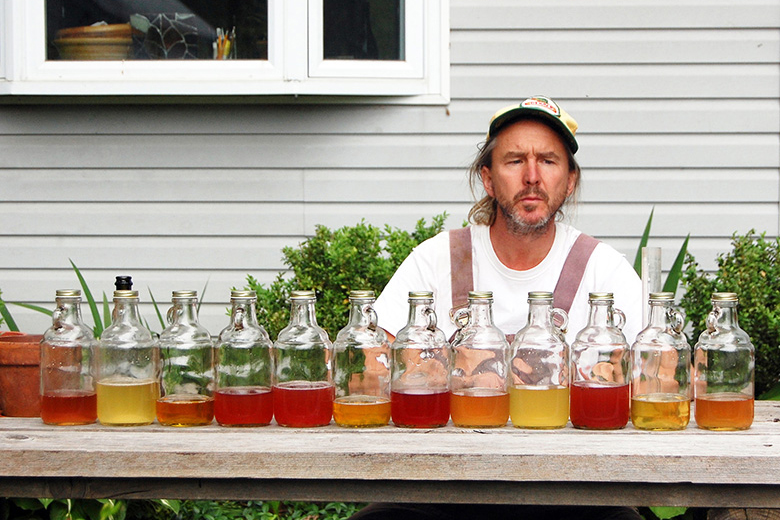
Early in his fascinating new book Uncultivated Wild Apples, Real Cider, and the Complicated Art of Making a Living (Chelsea Green Publishing 2019—also this writer’s publisher), the contrarian Sullivan County cider maker and artist Andy Brennan sets the tone for what will follow in the next 258 pages. His nascent love of a derelict apple orchard near a Chesapeake Bay fishing shack where the self-described introvert (a word that appears almost as often as “apple” in these pages) fled the stresses of New York City to spend summers and happily lonesome autumns is the anchor for what follows. He painted the orchard, collected the apples and describes the place as “a refuge for the feral.”
As much as it is a guide to cidering, Uncultivated is a treatise on escaping, rewilding and coming to terms with having to live. And a magnum opus on why overlooking cider “must surely be America’s greatest culinary blunder during the last century.”

From that 90s awakening in the abandoned orchard, the reader treks forward with the author to the hills of the Catskills where uncultivated apple trees camouflage themselves in the forest, and then deep into his cider-making journey and the practical practice of making it. The hard way.
Brennan’s Aaron Burr Cider is well known to the sommelier-cognoscenti of New York’s fine dining scene, as well as to his CSA subscribers and the lucky famers market patron who manages to snag an elusive seasonal bottle at a Sullivan County farmers market. Aaron Burr sells for stratospheric prices. Uncultivated explains why.

The author writes that verbal language came to him with difficulty (his first word was “apple”—of course—at the age of four). He has caught up, switching gracefully between autobiographical narrative of the past to present-day, with interjections of hard-core apple and cider industry facts, and illuminating as well as painstakingly researched and analytical statistical minutiae. With columns. There are memorably lyrical passages in Uncultivated, especially those associated with Brennan’s physical proximity to apple trees.
Brennan would like us to anthropomorphize apple trees. If we identify with the trees we will understand the cider. He also believes that apples are designed to be eaten off the ground, that apple trees belong in forests, and that cider apples (should) taste quite horrible. A two-paragraph treatise on a Denniston Red apple’s flavor profile is unforgettable. It includes an impression of “a low foaming washing machine full of raw linens, scarlet napkins, lacy panties, and a burlap sack that ruptures to spill its contents: lemons, avocadoes, super-ripe mango and a quart of sesame oil.”
For New Yorkers, his cold plunges into local history can be illuminatingly chilling. Did you know about the Sullivan Expedition? “My county is named in honor of the man responsible for starving the Iroquois nation to death and for killing more apple trees than anyone in human history.”

Aspirant cider makers reading Uncultivated will learn about the practical aspects of the craft. Consumers will learn how the mass-produced stuff is made. Lovers of good food and drink will reconsider their cider expectations as well their reluctance to pony up for a bottle of good cider. Thanksgiving menus and libations (see page 128) may be redesigned. And lovers of good books who never down a drop will simply be taken to a place they have never been; one that is hard to forget.
Brennan writes that “the product is not the physical drink inside the bottle—or even the taste of cider itself—but the appreciation of the life…. The satisfaction exists with or without the need of this physical evidence.” This is just as well. I have never tasted a drop of Aaron Burr cider, and it is unlikely I ever will. And that is not the point. Uncultivated speaks for cidering and how it could be, and sometimes is. Regardless, you will come to the end of its pages feeling very, very thirsty.



